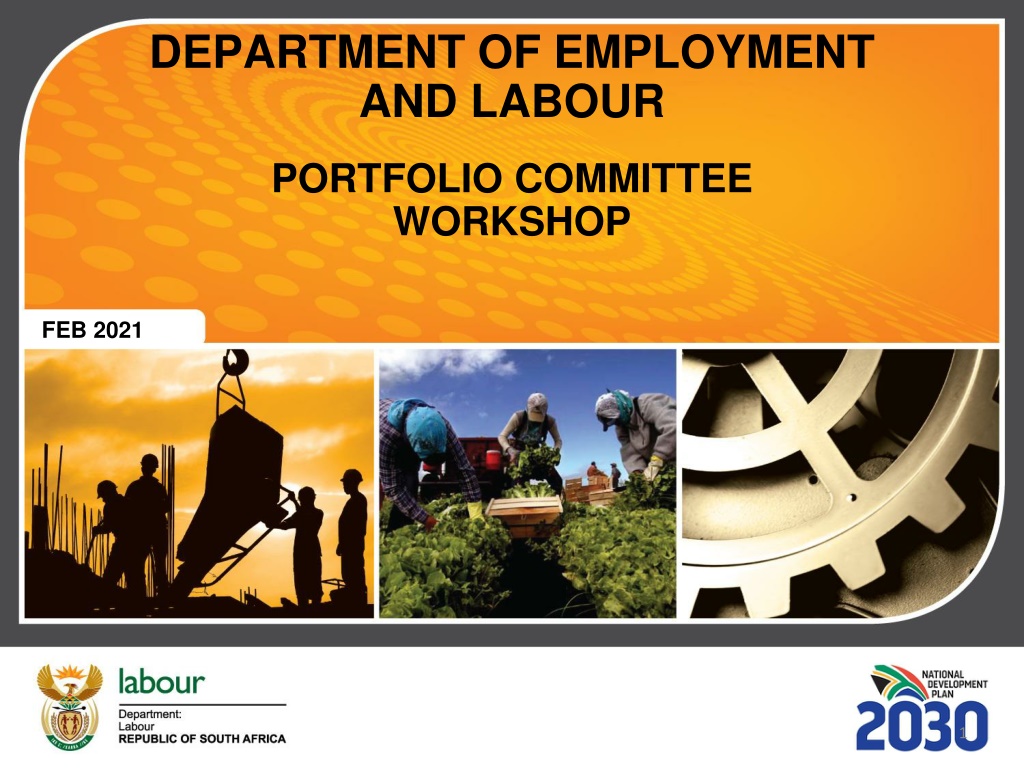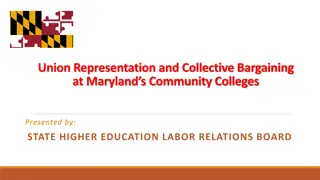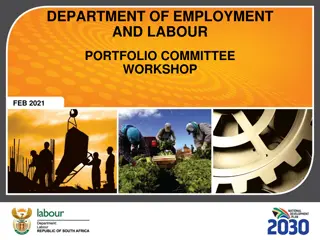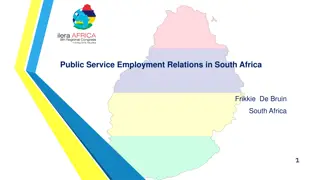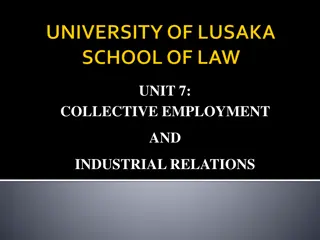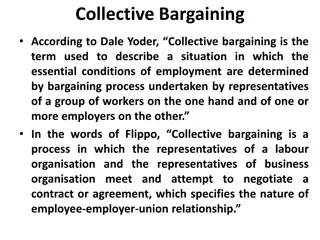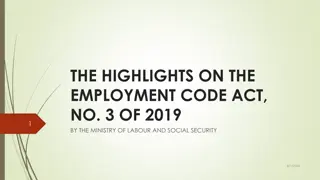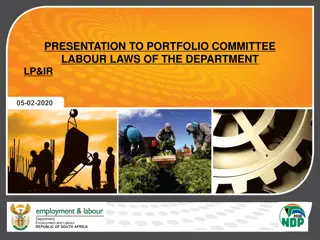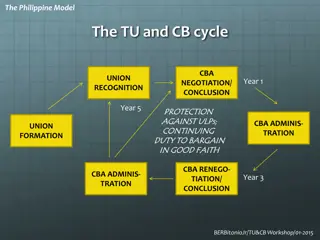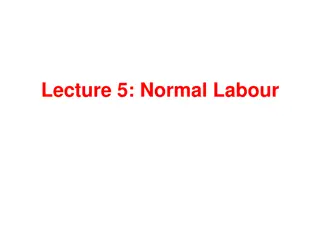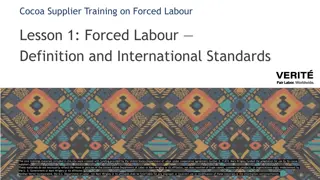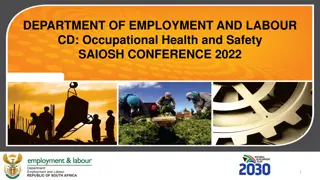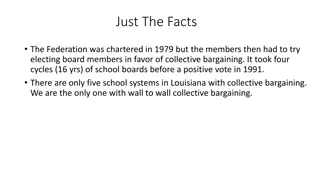Understanding Collective Bargaining in the Department of Employment and Labour Portfolio Committee Workshop
The Department of Employment and Labour Portfolio Committee Workshop in February 2021 focused on the importance of collective bargaining in South Africa. The workshop highlighted the protection of the right to engage in collective bargaining as outlined in the country's Constitution and the significance of centralized bargaining at different levels. It discussed the roles of trade unions, employers' organizations, and bargaining councils in negotiating wages, terms, and conditions of employment, aiming to improve workers' standards of living and reduce inequalities.
Download Presentation

Please find below an Image/Link to download the presentation.
The content on the website is provided AS IS for your information and personal use only. It may not be sold, licensed, or shared on other websites without obtaining consent from the author. Download presentation by click this link. If you encounter any issues during the download, it is possible that the publisher has removed the file from their server.
E N D
Presentation Transcript
DEPARTMENT OF EMPLOYMENT AND LABOUR PORTFOLIO COMMITTEE WORKSHOP FEB 2021 1
2 COLLECTIVE BARGAINING The Constitution of the Republic protects the right of every trade union, employers' organisation and employer to engage in collective bargaining. The country has ratified ILO convention on the Right to Organise and Collective Bargain, Convention, 1949 (No,98). The LRA gives effect to and regulates the fundamental rights conferred by the Constitution on collective bargaining; and obligations incurred as a member state of the ILO. The LRA promotes orderly collective bargaining and provides a framework within which employees and their trade unions, employers and employers organisations can collectively bargain to determine wages, terms and conditions of employment and other matters of mutual interest; and formulate industrial policy. A collective agreement means a written agreement concerning terms and conditions of employment or any other matter of mutual interest concluded by one or more registered trade unions on the one hand and on the other hand: one or more employers or one or more registered employers organisation or one or more employers and one or more registered employers' organisation 2
3 LEVELS OF BARGAINING Centralised bargaining: This happens when a trade union(s) and employers organisation o employers organisations establish centralised bargaining forums. Centralised bargaining forums allow unions to negotiate with all employers in the sector or industry. The most common centralised bargaining forum is the bargaining council system, chamber of mines and automobile manufacturing industry. Company level: Negotiations can also happen at the company level. Shop stewards are elected and mandated from the different workplaces of a company. They would then form a negotiating team. Plant level: This is when negotiations happen at a single workplace. But, negotiations at plant level can also happen at another level. For example, centralised bargaining at the national level could establish a framework of minimum standards which workers might seek to improve at a plant level. 3
4 Centralised Bargaining Level The LRA promotes centralized collective bargaining through the establishment of bargaining councils. The system of bargaining councils is voluntary system and its formation could be by a trade union(s); and employers organization or employers organizations acting together. The power of bargaining councils amongst others are: to conclude collective agreements; to enforce those collective agreements; to prevent and resolve labour disputes; to perform the dispute resolution functions; to establish and administer a fund to be used for resolving disputes; and to promote and establish training and education schemes. Bargaining councils could request the Minister to extend concluded collective agreements to non-parties. Extension of collective agreements to non-parties improve vulnerable workers wage thus improving their standard of living; and fighting poverty and inequalities. It extends social security benefits to workers who normally would have been excluded if collective agreements would have not been extended to all workers in the sector. 40 registered bargaining councils: 21 -national;, 14 provincial and 5 towns and city level. 4
5 Performing Bargaining Councils For the past five years the Department has extended more than 100 collective agreements to non-parties covering 2 229 269 employees. During Covid-19, some bargaining councils concluded collective agreements on occupational health and safety measures. Namely, Clothing Bargaining Council; Textile Bargaining Council; Electrical Bargaining Council; and South African Road Passenger Bargaining Council. Most of the bargaining councils are accredited to conduct dispute resolution, they perform dispute resolution function akin to the CCMA which is critical for industrial peace. They enforce collective agreements by bargaining councils within their sectors, by doing so they improve the standard of living, conditions of service and extend social security benefits to vulnerable workers. 5
6 Challenges faced by collective bargaining The proliferation of labour organisations led to diverse positions in the bargaining unit making negotiations cumbersome and difficult to reach agreement amongst parties. Some parties intransigent is just a ploy to recruit members rather than engaging in a genuine collective bargaining thus weakening the system. The system is infiltrated by parties that do not have the interest of collective bargaining at heart. Their intention is to see the demise of the system of collective bargaining. Rather than using the processes to strengthen collective bargaining, they used the processes to serve as an impediment to the system. Some trade unions were found to be involved in corruption rather than pursuing employees agenda. In the chemical sector, workers were left vulnerable by the demised of CEPPWAWU; and SAMWU in the local government sector. The dwindling of membership of trade unions. This might have been caused by factors like the 2008 economic crisis and Covid-19. However, before these crises the membership of the trade unions was already dwindling because the trade unions stopped recruitment and organising which is the basic tool for trade union growth. 6
7 DEALING WITH CHALLENGES The Department has gone out of its way to ensure that collective bargaining does not die. The Labour Relations Act was amended to allow either one of the parties that is in majority to extend a collective agreement to non-parties. Before, the law would require both parties to be in majority. Furthermore, the law was amended to allowed the Registrar of Labour Organisations to approach the Labour Court to appoint an administrator with attempt to resolve the challenges of the bargaining council. To avoid the collapsing of bargaining councils, the law has now given the Minister the power to extend a period of operation of funding agreements. To collapse a council, a party could refuse the council to request an extension of a funding agreement that is responsible for the existence of the council. 7
SECTORAL DETERMINATIONS 8
SECTORAL DETERMINATIONS: INTRODUCTION & BACKGROUND o Department of Employment and Labour s mandate is: Protection of vulnerable workers. How? o The Basic Conditions of Employment Act (BCEA) of 1997 (amended 2002) provides for the promulgation of sectoral determinations which establish conditions of employment for employees in specific sectors of the economy. o The BCEA (s51-58) and the National Minimum Wage Act (NMWA) of 2018 (s11) mandates the National Minimum Wage Commission to investigate the conditions of employment in sectors and to advise the Minister on the establishment of sectoral determinations in sectors which they are likely to be exploited, or where worker organizations and trade unions are absent. 9
PROCESS OF INVESTIGATION o Phase 1: Government notice with terms of reference o s52 of the BCEA provides that a sectoral determination must be preceded by an investigation into existing conditions of employment in the identified sector or area. o The Commission first publishes a notice in the Government Gazette containing the terms of reference of the investigation and calling for written representation by members of the public. o Phase 2: Consultation with stakeholders o Public hearings & site visits are also scheduled around the country to allow stakeholders in the sector to further submit their inputs regarding the investigation. o Participation in the investigation understanding, acceptance and implementation of any sectoral determination that is eventually made. helps to improve the 10
PROCESS OF INVESTIGATION CONTINUED.. o Phase 3: Preparation of the report o After the investigation, the Commission must prepare a report which covers the factual findings of the investigation, including the various views of the stakeholders in the sector. o The Commission is expected to consider the following factors into account when advising the minister on the publication of a sectoral determination. o The ability of employers to carry on their business successfully; o The operation of small, medium or micro-enterprises, and new enterprises; o Conditions of employment, Wage differentials and inequality; o The likely impact of any proposed condition of employment on current employment or the creation of employment; o The cost of living & the alleviation of poverty. 11
NUMBER OF SECTORAL DETERMINATIONS Currently, there are nine sectoral determinations and there are no new sectoral determinations that are anticipated to be established at this stage. Sectoral Determination No. Sectoral Determination Name Sectoral Determination No. 1 Contract Cleaning Sector Sectoral Determination No. 5 Learnership Sector Sectoral Determination No. 7 Domestic Sector Sectoral Determination No. 9 Wholesale and Retail Sector Sectoral Determination No. 10 Children in the Performance of Advertising, Artistic and Cultural Activities Sectoral Determination No. 11 Taxi Sector Sectoral Determination No. 12 Forestry Sector Sectoral Determination No. 13 Farm Sector Sectoral Determination No. 14 Hospitality Sector 12
DEFINITIONS OF SECTORAL DETERMINATIONS SD Definition of the sector Contract Cleaning Sector Contract Cleaning Sector" means the sector in which employers and employees are associated on a fixed-term or fixed-project contract for the purpose of cleaning or washing by hand or machine, of furniture, windows, carpets, doors, floors, tools, machinery, under supervision at industrial and commercial premises, buildings, and flats that are let commercially or any airplanes, trucks, cars, buses, trains or any other vehicle requiring to be so cleaned. Learnership Sector LearnershipSector where workers have concluded learnership agreements contemplated in section 17 of the Skills Development Act, 1998. Domestic Sector domesticworker means any domestic worker or independent contractor who performs domestic work in a private household and who receives, or is entitled to receive, pay and includes - a gardener; a person employed by a house hold as a driver of a motor vehicle; and a person who takes care of children, the aged, the sick, the frail or the disabled; domestic workers employed or supplied by employment services. 13
DEFINITIONS OF SECTORAL DETERMINATIONS CONTINUED SD Definition of the sector Wholesale & Retail Sector wholesale and retail sector meansthe sector in which employers and employees are mainly or wholly associated for the purpose of procuring products from any supplier or manufacturer for the purpose of sale to any person, whether on a wholesale or retail basis and, in addition, includes any other activities engaged in by an employer in the wholesale and retail sector including, but not limited to, merchandising, warehousing or distribution operations that are incidental to, or supportive of, the employer s enterprise. CIPA CIPA applies to the employment of children under 15 years of age in advertising, artistic and cultural activities. Taxi Sector taxi sector means the sector in which employers and employees are associated for the purpose of conveying for reward on any public road any person by means of a self-propelled vehicle intended to carry not more than 35 persons, including the driver simultaneously, and includes all operations incidental thereto or consequent thereon but excludes the metered taxi industry. 14
DEFINITIONS OF SECTORAL DETERMINATIONS CONTINUED SD Definition of the sector Forestry Sector forestrysector meansthe forestry activities related to planting, growing, tending and harvesting of trees. Farm Sector farmingactivities includes primary and secondary agriculture, mixed farming, horticulture, aqua farming and the farming of animal products or field crops excluding the Forestry Sector. Hospitality Sector hospitalitysector means any commercial business or part of a commercial business in which employers and employees are associated for the purposes of carrying on or conducting one or more of the following activities for reward: providing accommodation in a hotel, motel, inn, resort, game lodge, hostel, guest house, guest farm or bed and breakfast establishment, including short stay accommodation, self- catering, timeshares, camps, caravan parks: restaurants, pubs, taverns, cafes, tearooms, coffee shops fast food outlets, snack bars, industrial or commercial caterers, function caterers, contract caterers that prepare, serve or provide prepared food or liquid refreshments, other than drinks in sealed bottles or cans whether indoor or outdoors or in the open air. 15
ENFORCEMENT OF SECTORAL DETERMINATIONS How have SDs been adhered to? SD s form part of the Basic Conditions of Employment Act and they are sector specific. The adherence to is determined through BCEA inspections that are conducted in various workplaces. To a large extent, SD s have been adhered to. For example, for the Financial Year 2019/20, 166 368 BCEA inspections were conducted. Of these, 162 031 were found to be compliant. This is 97.6% compliance level. How have they been enforced? The SD s are enforced through the Basic Conditions of Employment Act. The SD s basically regulate conditions of employment in specific sectors. The overarching act in this regard is the BCEA. Sector specific variations are then regulated through various SD s. 16
17 Thank You
